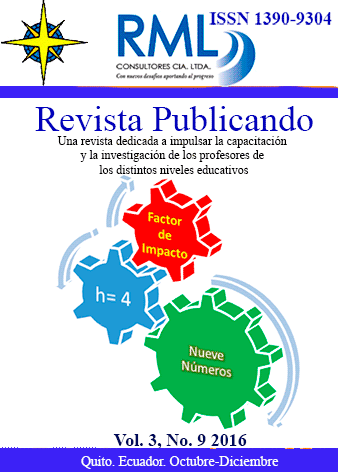Abstract
Este artículo se propuso realizar una revisión bibliográfica sobre las publicaciones reportadas sobre “coopetition”. A partir de la revisión realizada en Scopus se pudo analizar la distribución de 265 referencias por año, disciplina y por países. Se pudieron precisar los artículos de mayor impacto en esta temática.
Como direcciones investigativas de importancia se determinaron:
a) Aplicación de la Teoría de juegos
b) Relación de la coopetición con la Innovación.
c) El análisis de la relación entre la distribución del conocimiento y la coopetición.
Se analiza que la coopetición es un campo de investigación en pleno desarrollo en que la misma definición del término necesita ser refinada y deben desarrollarse investigaciones que permitan comprender como esta afecta los modelos de negocios
References
Barone, T. A. (1995). Coopetition: The wave of the future. Catholic healthcare providers must work with others to remain viable. Health progress (Saint Louis, Mo.), 76(1), 51-52.
Bengtsson, M., et al.Kock, S. (2000). "Coopetition" in business networks - to cooperate and compete simultaneously. Industrial Marketing Management, 29(5), 411-426.
Cleghorn, G. D. (1992). Coopetition in rural health education: The south carolina ahec model. The Journal of the South Carolina Medical Association, 88(10), 462-465.
Chevallier, C., Laarraf, Z., Lacam, J. S., Miloudi, A., et al.Salvetat, D. (2016). Competitive intelligence, knowledge management and coopetition: The case of european high-technology firms. Business Process Management Journal, 22(6), 1192-1211. doi: 10.1108/BPMJ-11-2015-0161
Chin, K. S., Chan, B. L., et al.Lam, P. K. (2008). Identifying and prioritizing critical success factors for coopetition strategy. Industrial Management and Data Systems, 108(4), 437-454. doi: 10.1108/02635570810868326
Dorn, S., Schweiger, B., et al.Albers, S. (2016). Levels, phases and themes of coopetition: A systematic literature review and research agenda. European Management Journal, 34(5), 484-500. doi: http://dx.doi.org/10.1016/j.emj.2016.02.009
Estrada, I., Faems, D., et al.de Faria, P. (2015). Coopetition and product innovation performance: The role of internal knowledge sharing mechanisms and formal knowledge protection mechanisms. Industrial Marketing Management. doi: 10.1016/j.indmarman.2015.11.013
Friedman, B. A., et al.Barnes, B. W. (1992). Client-server design provides model for 'coopetition' alliances. Computers in healthcare, 13(9), 38-39.
Granata, J., Géraudel, M., Gundolf, K., Gast, J., et al.Marquí¨s, P. (2016). Organisational innovation and coopetition between smes: A tertius strategies approach. International Journal of Technology Management, 71(1-2), 81-99. doi: 10.1504/IJTM.2016.077975
Loebbecke, C., et al.Angehrn, A. (2010). Knowledge management under coopetition Encyclopedia of knowledge management (Vol. 1, pp. 791-803).
Luo, X., Slotegraaf, R. J., et al.Pan, X. (2006). Cross-functional "coopetition": The simultaneous role of cooperation and competition within firms. Journal of Marketing, 70(2), 67-80. doi: 10.1509/jmkg.70.2.67
Luo, Y. (2005). Toward coopetition within a multinational enterprise: A perspective from foreign subsidiaries. Journal of World Business, 40(1), 71-90. doi: 10.1016/j.jwb.2004.10.006
Luo, Y. (2007). A coopetition perspective of global competition. Journal of World Business, 42(2), 129-144. doi: 10.1016/j.jwb.2006.08.007
Okura, M., et al.Carfi, D. (2014). Coopetition and game theory. Journal of Applied Economic Sciences, 9(3), 457-466.
Qi, G. Q., Yang, X. H., et al.Li, S. (2006). Coopetition analysis of clustered network supply chain by repetitive game theory. Dongbei Daxue Xuebao/Journal of Northeastern University, 27(2), 233-236.
Ritala, P., et al.Hurmelinna-Laukkanen, P. (2009). What's in it for me? Creating and appropriating value in innovation-related coopetition. Technovation, 29(12), 819-828. doi: 10.1016/j.technovation.2009.07.002
Ritala, P., et al.Hurmelinna-Laukkanen, P. (2013). Incremental and radical innovation in coopetition-the role of absorptive capacity and appropriability. Journal of Product Innovation Management, 30(1), 154-169. doi: 10.1111/j.1540-5885.2012.00956.x
Ritala, P., Ví¤limí¤ki, K., Blomqvist, K., et al.Henttonen, K. (2009). Intrafirm coopetition, knowledge creation and innovativeness Coopetition strategy: Theory, experiments and cases (pp. 64-73).
Tsai, W. (2002). Social structure of "coopetition" within a multiunit organization: Coordination, competition, and intraorganizational knowledge sharing. Organization Science, 13(2), 179-190.
Velu, C. (2015). Evolutionary or revolutionary business model innovation through coopetition? The role of dominance in network markets. Industrial Marketing Management. doi: 10.1016/j.indmarman.2015.11.007
Wang, Y., et al.Krakover, S. (2008). Destination marketing: Competition, cooperation or coopetition? International Journal of Contemporary Hospitality Management, 20(2), 126-141. doi: 10.1108/09596110810852122
Weber, S. (1991). Executive briefing. Anatomy of 'coopetition'. Electronics, 64(8), 37-38.
Wemmer, F., Emrich, E., et al.Koenigstorfer, J. (2016). The impact of coopetition-based open innovation on performance in nonprofit sports clubs. European Sport Management Quarterly, 16(3), 341-363. doi: 10.1080/16184742.2016.1164735
Werner, K., Dickson, G., et al.Hyde, K. F. (2015). Coopetition and knowledge transfer dynamics: New zealand's regional tourism organizations and the 2011 rugby world cup. Event Management, 19(3), 365-380. doi: 10.3727/152599515X14386220874841
Wood, L. C. (2012). Coopetition in supply chains: A case study of a coopetitive structure in the horticulture industry Customer-oriented global supply chains: Concepts for effective management (pp. 76-93).
Yami, S., Castaldo, S., Dagnino, G. B., et al.Le Roy, F. (2010). Coopetition: Winning strategies for the 21st century.
You are free to:
Share — copy and redistribute the material in any medium or format.
Adapt — remix, transform, and build upon the material.
The licensor cannot revoke these freedoms as long as you follow the license terms.
Under the following terms:
Attribution — You must give appropriate credit, provide a link to the license, and indicate if changes were made. You may do so in any reasonable manner, but not in any way that suggests the licensor endorses you or your use.
NonCommercial — You may not use the material for commercial purposes.
ShareAlike — If you remix, transform, or build upon the material, you must distribute your contributions under the same license as the original.
No additional restrictions — You may not apply legal terms or technological measures that legally restrict others from doing anything the license permits.
